Alcohol and late night refreshment licensing, England and Wales, 31 March 2017
Published 19 October 2017
Applies to England and Wales
1. Introduction
This release provides statistics on alcohol and late night refreshment licensing in England and Wales, and is based on information from licensing authorities (LAs) that completed a statistical return. The overall response rate was 99% as 345 out of 350 LAs in England and Wales provided a statistical return (Copeland, Denbighshire, Oadby and Wigston, Sheffield and Swindon were unable to provide returns). However, of the responding LAs, some were unable to provide data for all of the requested fields (see the Licence Questionnaire for the response rate for each question).
To minimise administrative burden on LAs, the Home Office did not collect data for the years ending 31 March 2011 and 31 March 2015 as the main purpose of the collection is to monitor the administration of new and amended legislation.
The figures in this release are provided in the Alcohol and late night refreshment licensing, England and Wales, 31 March 2017 tables and include the LA breakdowns back to 31 March 2012. Figures based solely on returns received from LAs (i.e. figures which exclude imputed estimates) are provided unrounded in the commentary and the data tables. This is to promote transparency and to allow users to exploit the data further.
To allow meaningful comparisons to be made between years, the headline figures include imputed estimates for the LAs unable to supply data (see Chapter 2 of the user guide for an explanation of the methodology). These figures are rounded to the nearest hundred. The headline figures as at 31 March 2017 show that:
- there were 211,500 premises licences, a 1% increase of 1,100 compared with 31 March 2016
- there were 14,300 club premises certificates, a 3% decrease of 400 compared with 31 March 2016
- there were 689,600 personal licences, a 6% increase of 41,700 compared with 31 March 2016
- there were 88,000 premises licences with late night refreshment, a 0.1% decrease of 100 compared with 31 March 2016
- there were 8,000 premises with 24-hour alcohol licences, the same as at 31 March 2016
The Home Office uses the statistics in this release to monitor the administration of the 2003 Act and subsequent amendments, such as those introduced by the Police Reform and Social Responsibility Act 2011 (the 2011 Act). The Home Office also uses the statistics to inform policy development, to understand how licensing operates in practice, to respond to queries and to assess the potential impact of legislative changes upon LAs and licensed premises. More widely, the statistics also help LAs to benchmark their position against other LAs and to understand the national picture.
2. Premises licences
2.1 Introduction
A premises licence gives authority under the 2003 Act for a premises to be used for the sale of alcohol, the provision of regulated entertainment, or the provision of late night refreshment.
The number of premises licences as at 31 March 2017 comprised of data received from 99% (345 out of 350) of LAs and imputed estimates for the remaining 1% (5 LAs). This compares with data received from 99% of LAs (346) and imputed estimates for the remaining 1% (4 LAs) for the number of premises licences as at 31 March 2016. Information on the response rates are available from the Licence Questionnaire.
2.2 Headline figures (including imputed estimates)
There were 211,500 premises licences in England and Wales as at 31 March 2017, a 1% increase of 1,100 compared with 31 March 2016. This is in line with the broadly increasing trend since 31 March 2008 (195,800) (see Table 1 of the data tables).
Figure 1: Premises licences, England and Wales, 31 March 2010 to 2017
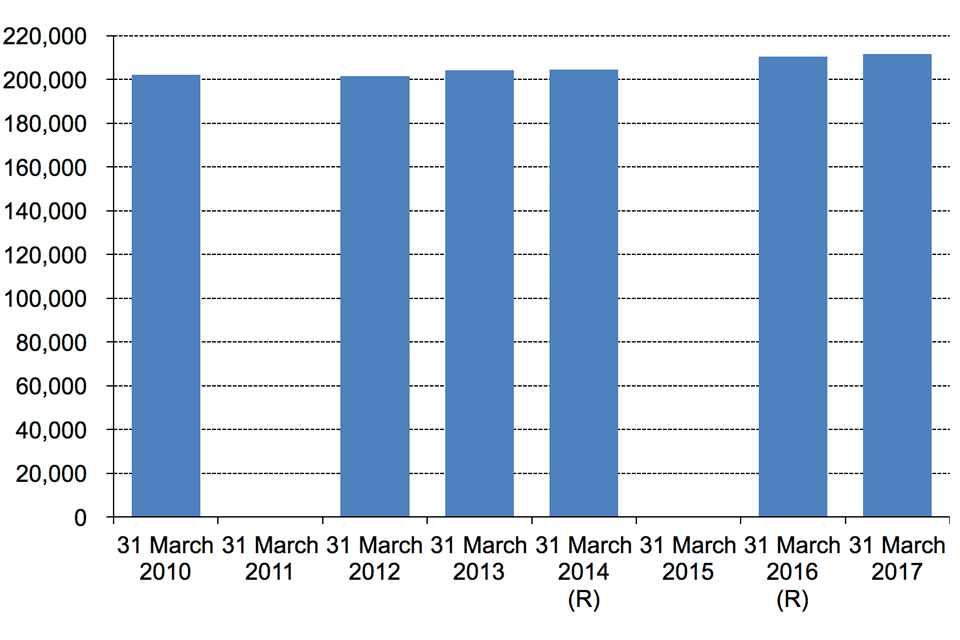
Chart notes
Source: Home Office, Alcohol and late night refreshment licensing, England and Wales, 31 March 2017, Table 1.
R=Revised figures.
Data were not collected for years ending 31 March 2011 and 2015.
Figures for all years except 31 March 2014 include imputed estimates for non-responding LAs.
In relation to premises that are permitted to sell alcohol: on-sales refers to those which can sell alcohol for consumption on the premises; and off-sales refers to those which can sell alcohol for consumption off the premises. As at 31 March 2017:
- there were 39,500 premises licences that authorised on-sales of alcohol only, a 1% increase of 300 compared with 31 March 2016
- there were 54,900 premises licences that authorised off-sales of alcohol only, a 1% increase of 400 compared with 31 March 2016
- there were 81,800 premises licences that authorised both on- and off-sales of alcohol, a 1% increase of 900 compared with 31 March 2016
2.3 Premises licences by fee band
There are 5 distinct fee bands for premises, which are based on the non-domestic rateable value of the premises. No fee is payable for premises licences authorised for regulated entertainment in educational institutions, church halls, village halls, parish halls, community halls or similar buildings. Whilst a fee may not be applicable, the premises licence may still have a fee band, unless one has not been assigned. Since the introduction of the 2003 Act, the application fees associated with each band for a new licence or certificate have been as follows: Band A (£100); Band B (£190); Band C (£315); Band D [no multiplier] (£450); Band D premises licence with multiplier (£900); Band E [no multiplier] (£635); Band E premises licence with multiplier (£1,905). The subsequent annual fees associated with each licence or certificate are as follows: Band A (£70); Band B (£180); Band C (£295); Band D [no multiplier] (£320); Band D premises licence with multiplier (£640); Band E [no multiplier] (£350); Band E premises licence with multiplier (£1,050). The glossary of the user guide contains more detail on fee bands.
There were 208,051 premises licences as at 31 March 2017 and of these, fee band information was reported for 181,474 licences. Around half (55% or 99,791) were in Band B. The next largest fee band was Band A accounting for 18% (33,371) of premises licences.
As at 31 March 2017, there were 10,392 premises licences (5% of the premises licences total) that did not attract a fee.
Figure 2: Premises licences by fee band, England and Wales, 31 March 2017
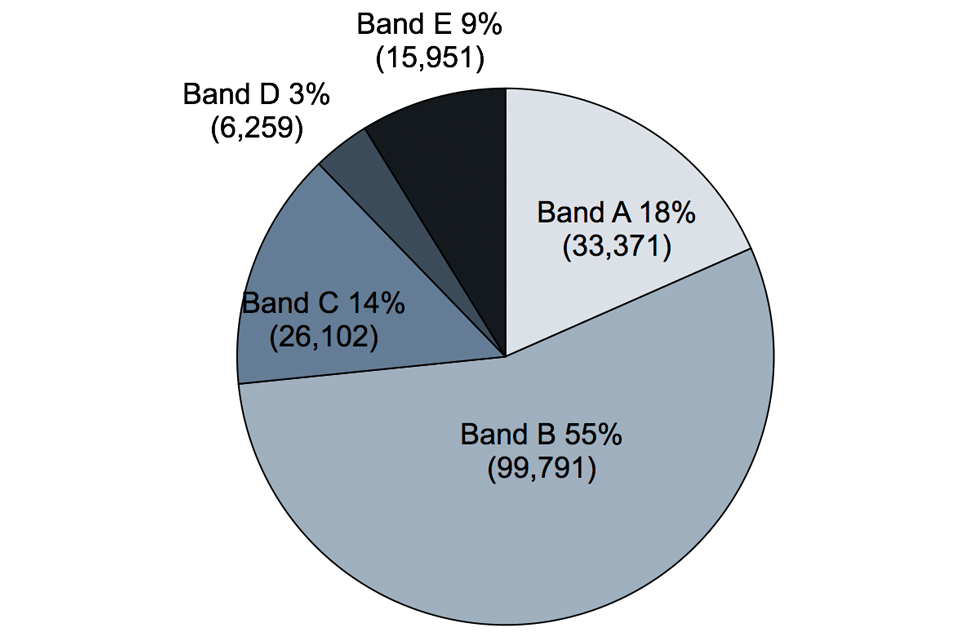
Chart notes
Source: Home Office, Alcohol and late night refreshment licensing, England and Wales, 31 March 2017, Table 2.
Bands D and E include premises licences where fee multipliers were applied.
Premises licences where the fee band was not known are excluded from this chart.
Premises licences that did not attract a fee but which still had a known fee band are included in this chart.
2.4 Premises licence activity and outcome
Figures for licences granted and refused may not necessarily relate to applications LAs received in the year ending 31 March 2017 as these outcomes may be associated with applications made in previous years. Similarly, applications made in the year ending 31 March 2017 may result in those applications being granted or refused in future years. This explains why the number of applications granted and refused may not necessarily equal the number of applications LAs received.
In the year ending 31 March 2017, LAs received 9,778 applications for new premises licences. Of these, 1,124 applications (11%) were in relation to premises within cumulative impact areas (see Section 8.1 for more information). In the same period, 9,175 decisions on applications for new premises licences were made; of these, 97% (8,937) were granted and 3% (238) were refused. Of the 9,175 decisions, 1,061 were in cumulative impact areas (94% granted, 6% refused).
In the year ending 31 March 2017, LAs received 5,229 applications to vary a premises licence. Of these, 578 applications (11%) were in relation to premises within cumulative impact areas. In the same period, 4,913 decisions on applications to vary a premises licence were made; of these, 98% (4,803) were granted and 2% (110) were refused. Of the 4,913 decisions made, 546 were in cumulative impact areas (93% granted, 7% refused).
The proportion of new licences granted and variations to licences granted in cumulative impact areas was less than the proportion granted overall.
In the year ending 31 March 2017, LAs received 6,203 applications for minor variations of a premises licence or club premises certificate (see Section 3.1 for description) (the figures cannot be broken down by premises licences or club premises certificates). In the same period, of the total minor variations to licences and or certificates where decisions were made, 96% (5,880) were granted and 4% (219) were refused.
In the year ending 31 March 2017, 4,617 premises licences were surrendered by the holder, 5,101 were suspended by an LA, 753 lapsed, 26 were affected by a closure notice, and 1 was suspended by a court.
3. Club premises certificates
3.1 Introduction
A club premises certificate allows a qualifying club to carry out activities specified under the Licensing Act 2003 (the 2003 Act).
The number of club premises certificates as at 31 March 2017 comprised of data received from 99% of LAs (345 out of 350) and imputed estimates for the remaining 1% (5 LAs). This compares with data received from 99% of LAs (347) and imputed estimates for the remaining 1% (3 LAs) for the number of club premises certificates as at 31 March 2016. Information on the response rates are available from the Licence Questionnaire.
3.2 Headline figures (including imputed estimates)
There were 14,300 club premises certificates in England and Wales as at 31 March 2017. This represents a 3% decrease of 400 compared with 31 March 2016 and continues the decline since 31 March 2008 (17,600) when the figures were first published (see Table 1 of the data tables).
Figure 3: Club premises certificates, England and Wales, 31 March 2010 to 2017
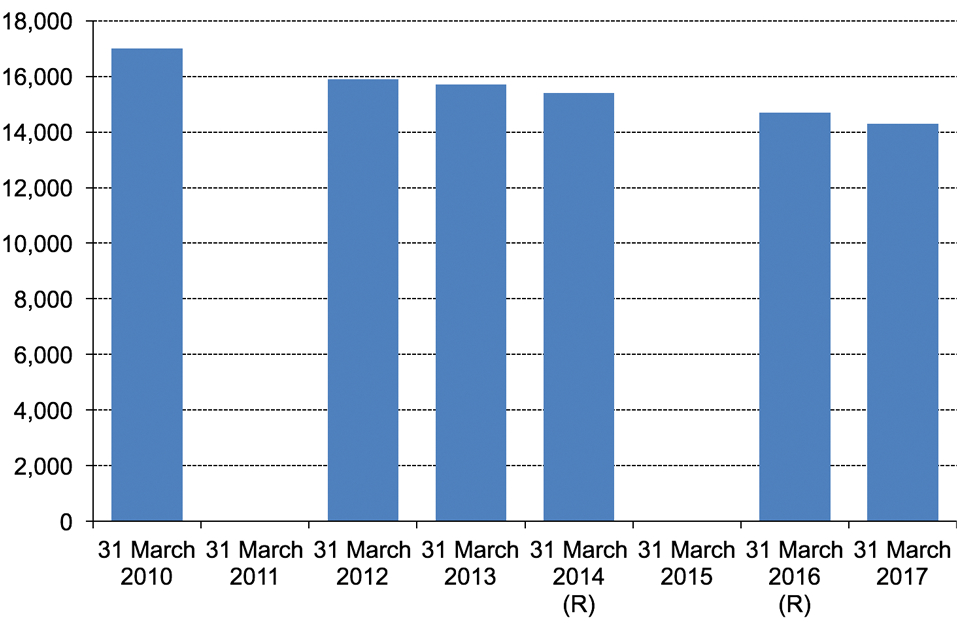
Chart notes
Source: Home Office, Alcohol and late night refreshment licensing, England and Wales, 31 March 2017, Table 1.
R = Revised figures.
Data were not collected for years ending 31 March 2011 and 2015.
Figures for all years except 31 March 2014 include imputed estimates for non-responding LAs.
In relation to club premises that are permitted to sell or supply alcohol: on-sales refers to those which can sell or supply alcohol for consumption on the premises; and off-sales refers to those which can sell or supply alcohol for consumption off the premises. As at 31 March 2017:
- there were 6,800 club premises certificates that authorised on-sales of alcohol only, a 1% decrease of 100 compared with 31 March 2016
- there were 7,200 club premises certificates that authorised both on-sales and off-sales of alcohol, a 4% decrease of 300 compared with 31 March 2016
3.3 Club premises certificates by fee band
There are 5 distinct fee bands for premises, which are based on the non-domestic rateable value of the premises. The glossary of the user guide contains more detail on fee bands.
There were 14,068 club premises certificates as at 31 March 2017; of these, fee band information was reported for 12,677 certificates. Almost two-thirds (62% or 7,918) were in Band B. The next largest fee band was Band A, which accounted for 30% (3,821).
As at 31 March 2017, 65 club premises certificates (0.5% of all club premises certificates) did not attract a fee.
Figure 4: Club premises certificates by fee band, England and Wales, 31 March 2017
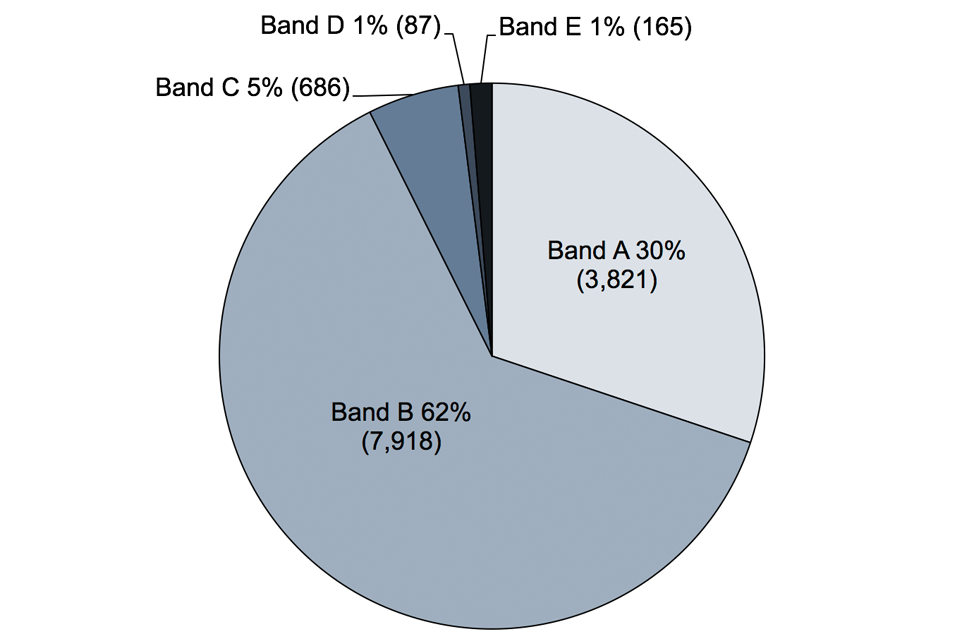
Chart notes
Source: Home Office, Alcohol and late night refreshment licensing, England and Wales, 31 March 2017, Table 2.
Club premises certificates where the fee band was not known are excluded from this chart.
Club premises certificates that did not attract a fee but which still had a known fee band are included in this chart.
3.4 Club premises certificate activity and outcome
Figures for club premises certificates granted and refused may not necessarily relate to applications LAs received in the year ending 31 March 2017 as these outcomes may be associated with applications made in previous years. Similarly, applications made in the year ending 31 March 2017 may result in those applications being granted or refused in future years. This explains why the number of applications granted and refused may not necessarily equal the number of applications LAs received.
In the year ending 31 March 2017, LAs received 84 applications for new club premises certificates. Of these, only 1 was in relation to a club premises within a cumulative impact area (see Section 8.1 for more information). In the same period, 77 decisions on applications for new club premises certificates were made; of these, 99% (76) were granted and 1% (1) was refused. Of the 77 decisions, only 1 was in relation to a club premises within a cumulative impact area and was granted.
In the year ending 31 March 2017, LAs received 71 applications to vary the terms of a club premises certificate. In the same period, 66 decisions were made, of which 98% (65) were granted and 2% (1) was refused. No applications or decisions were made in respect of club premises within cumulative impact areas
In the year ending 31 March 2017, 261 club premises certificates were surrendered by clubs, 195 were suspended by an LA and 65 were withdrawn.
4. Personal licences
4.1 Introduction
A personal licence authorises an individual to supply or authorise the supply of alcohol in accordance with a premises licence under the 2003 Act.
The number of personal licences as at 31 March 2017 comprised of data received from 99% of LAs (345 out of 350) and imputed estimates for the remaining 1% (5 LAs). This is the same response rate for the number of personal licences as at 31 March 2016. Information on the response rates are available from the Licence Questionnaire.
4.2 Headline figures (including imputed estimates)
There were 689,600 personal licences as at 31 March 2017. This represents a 6% increase (41,700) compared with 31 March 2016, and continues the increasing trend seen since 31 March 2008 (347,100) (see Table 1 of the data tables).
As individuals who are authorised to supply alcohol are not required to surrender their personal licences when they leave or retire from the alcohol industry, the increase does not necessarily reflect an increase in the employment of active personal licence holders.
Figure 5: Personal licences, England and Wales, 31 March 2010 to 2017
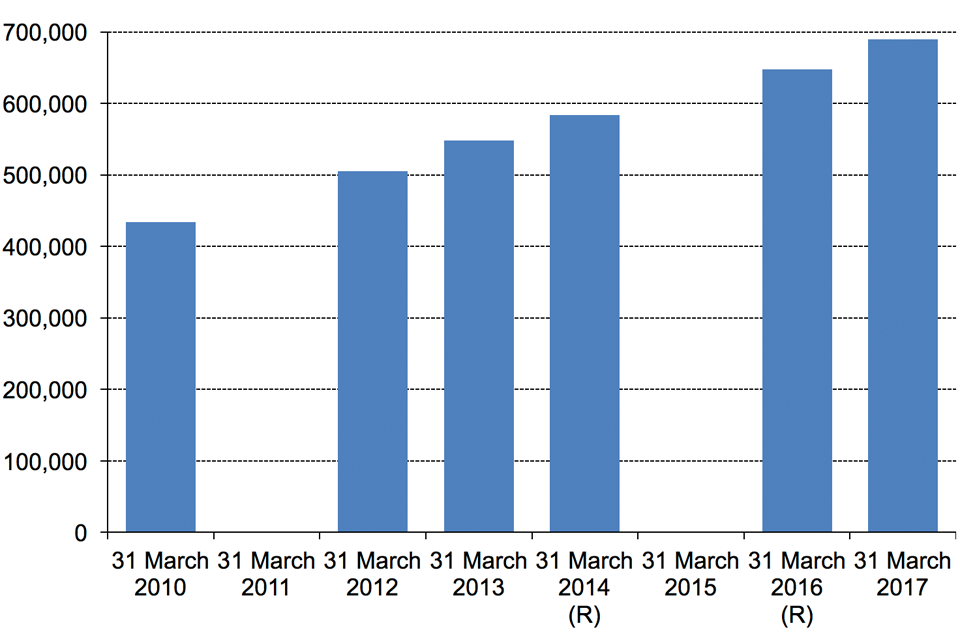
Chart notes
Source: Home Office, Alcohol and late night refreshment licensing, England and Wales, 31 March 2017, Table 1.
R = Revised figures.
Data were not collected for years ending 31 March 2011 and 2015.
Figures for all years except 31 March 2014 include imputed estimates for non-responding LAs.
4.3 Personal licences activity
In the year ending 31 March 2017, 337 personal licences were surrendered, 19 were revoked, 7 were forfeited and 3 were suspended by a court.
5. Late night refreshment
5.1 Introduction
Late night refreshment refers to:
- the provision of hot food or hot drink to the public, for consumption on or off the premises, between 11pm and 5am
- the supply of hot food or hot drink to any persons between 11pm and 5am on or from premises to which the public has access
The number of premises licences with late night refreshment as at 31 March 2017 comprised of data received from 92% of LAs (322 out of 350) with imputed estimates for the remaining 8% (28). This compares with data received from 90% of LAs (315) and imputed estimates for the remaining 10% (35 LAs) for the number of premises licences with late night refreshment as at 31 March 2016. Information on the response rates are available from the Licence Questionnaire.
5.2 Headline figures (including imputed estimates)
There were 88,000 premises licences with night refreshment as at 31 March 2017. Whilst there has been no consistent trend between 2010 and 2017, this represents a 0.1% decrease of 100 compared with 31 March 2016.
The number of premises licences with late night refreshment as at 31 March 2017 made up 42% of the total number of premises licences.
Figure 6: Premises licences with late night refreshment, England and Wales, 31 March 2010 to 2017
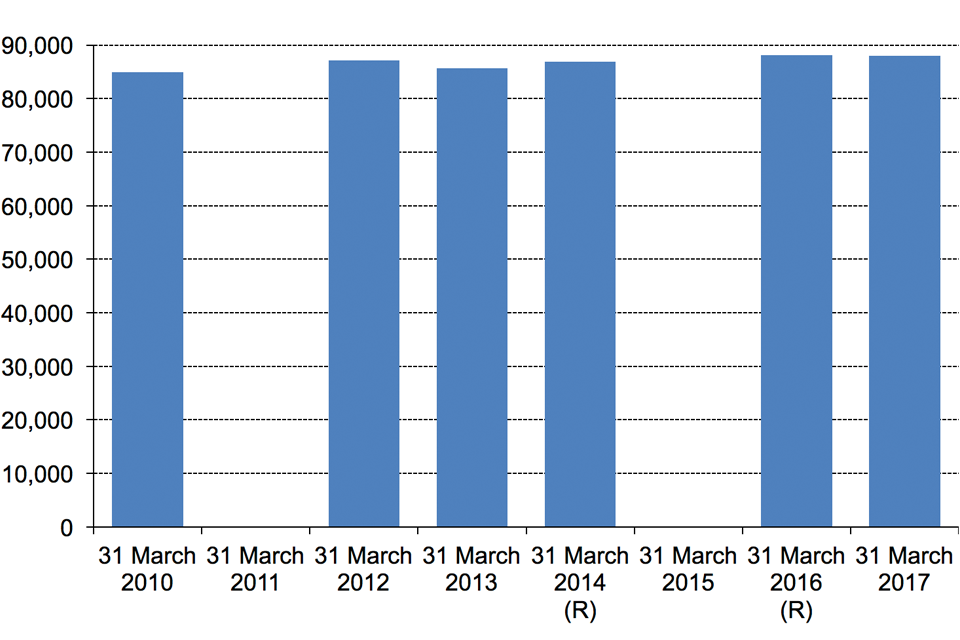
Chart notes
Source: Home Office, Alcohol and late night refreshment licensing, England and Wales, 31 March 2017, Table 1.
R = Revised figures.
Data were not collected for years ending 31 March 2011 and 2015.
Figures for all years except 31 March 2014 include imputed estimates for non-responding LAs.
5.3 Premises licences including or with only late night refreshment
As at 31 March 2017, LAs reported that 81,439 premises licences included late night refreshment and 16,548 premises licences were solely for late night refreshment.
6. 24-hour alcohol licences
6.1 Introduction
A 24-hour licence refers to premises that are licensed for the sale or supply of alcohol 24 hours per day.
The number of premises with 24-hour alcohol licences as at 31 March 2017 comprised of data received from 95% of LAs (331 out of 350) and imputed estimates for the remaining 5% (19). This compares with data received from 93% of LAs (325) and imputed estimates for the remaining 7% (25 LAs) for the number of premises with 24-hour alcohol licences as at 31 March 2016. Information on the response rates are available from the Licence Questionnaire.
6.2 Headline figures (including imputed estimates)
There were 8,000 premises with 24-hour alcohol licences as at 31 March 2017, the same number as at 31 March 2016.
Figure 7: Premises with 24-hour alcohol licences, England and Wales, 31 March 2010 to 2017

Chart notes
Source: Home Office, Alcohol and late night refreshment licensing, England and Wales, 31 March 2017, Table 1.
R = Revised figures.
Data were not collected for years ending 31 March 2011 and 2015.
Figures for all years except 31 March 2014 include imputed estimates for non-responding LAs.
6.3 Types of premises with 24-hour alcohol licences
There were 7,498 premises with 24-hour alcohol licences as at 31 March 2017. Of the 7,350 premises with a reported type:
- 43% (3,127) were for hotel bars, and of the 3,023 hotels bars with a reported breakdown:
- 86% (2,603) were open 24 hours to residents and their guests only
- 14% (420) were open to residents and the general public
- 33% (2,389) were for supermarkets and stores, and of the 2,350 supermarket/stores with a reported breakdown:
- 63% (1,486) were for other convenience stores
- 37% (864) were for large supermarkets
- 10% (728) were for pubs, bars, and nightclubs
- 15% (1,106) were for other premises types
Figure 8: Premises with 24-hour alcohol licences by premises type, England and Wales, as at 31 March 2017

Chart notes
Source: Home Office, Alcohol and late night refreshment licensing, England and Wales, 31 March 2017, Table 4.
Premises with 24-hour alcohol licences where the premises type was not reported (148) are excluded from this chart.
7. Reviews, hearings and appeals
7.1 Introduction
This section contains statistics on the number of reviews completed by LAs in England and Wales in the year ending 31 March 2017. An LA can be asked to review a licence on the grounds of it having an adverse impact on the licensing objectives (i.e. the prevention of crime and disorder, public safety, the prevention of public nuisance, and the protection of children from harm).
The number of completed reviews in the year ending 31 March 2017 comprised of data received from 99% of LAs (345 out of 350) and imputed estimates for the remaining 1% (5 LAs). This compares with data received from 97% of LAs (338) and imputed estimates for the remaining 3% (12 LAs) for the number of completed reviews in the year ending 31 March 2016. Information on the response rates are available from the Licence Questionnaire.
7.2 Headline figures (including imputed estimates)
In the year ending 31 March 2017, 600 reviews were completed, representing a 14% decrease of 100 compared with the year ending 31 March 2016. This continues the decline seen since 31 March 2010 (1,300) when the series began.
Figure 9: Completed reviews, England and Wales, 31 March 2010 to 2017

Chart notes
Source: Home Office, Alcohol and late night refreshment licensing, England and Wales, 31 March 2017, Table 1.
R = Revised figures.
Data were not collected for years ending 31 March 2011 and 2015.
Figures for all years except 31 March 2014 include imputed estimates for non-responding LAs.
7.3 Completed reviews
In the year ending 31 March 2017, 177 LAs had completed at least one review, with 31 being the maximum number completed in any one LA. No review was completed in 168 LAs.
In relation to the number of completed reviews in the year ending 31 March 2017:
- 80% (471) were for premises licences following a general application for a review
- 16% (94) were for premises licences following an application by the police for an expedited review
- 3% (15) were for premises licences following a closure order
- 1% (6) were for club premises certificates following a general application for a review
Regarding the reason for completed reviews (or reasons, as more than one was cited in some instances):
- 467 were for crime and disorder, of which 93 reviews related to the sale of illicit alcohol
- 195 were for public nuisance
- 176 were for public safety
- 131 were for the protection of children
Of the total completed reviews in the year ending 31 March 2017 where the responsible authority was reported on:
- 52% (309) were instigated by the police
- 20% (120) were instigated by trading standards
- 7% (44) were instigated by environmental health officers
- 6% (37) were instigated by local residents
- 13% (78) were instigated by other responsible authorities or interested parties
Regarding the action (or actions) taken following reviews:
- 376 reviews resulted in conditions being added to the licence or modified
- 207 resulted in a licence being revoked or a club premises certificate being withdrawn
- 61 resulted in the designated supervisor being removed (for premises licences only)
- 88 resulted in a licence or certificate being suspended
- no action was taken following 30 reviews
7.4 Expedited reviews
Expedited review powers allow the police to trigger a fast-track process to review a premises licence where they consider a premises to be associated with serious crime and/or serious disorder, and allow the LA to quickly respond by taking interim steps, where appropriate, pending a full review. Interim steps are temporary measures which have to be taken within 48 hours of the application for an expedited review.
In the year ending 31 March 2017, LAs received 100 applications for an expedited review. In the same period, 1 application was withdrawn.
Interim steps were taken for 87 expedited reviews and no interim steps were taken for 8 reviews. Where interim steps were taken (more than 1 interim step can be taken per review):
- the licence was suspended in 74 cases
- other conditions were added or modified in 26 cases
- the operating hours were modified in 12 cases
- the designated premises supervisor was removed in 12 cases
- the licensable activity was partially restricted in 3 cases
- the licensable activity was completely excluded in 1 case
7.5 Hearings, appeals and judicial reviews
In the year ending 31 March 2017, 285 LAs accounted for the 2,480 premises licence and or club premises certificate applications that went to a committee hearing, with the number ranging from 1 to 200 applications in any one particular LA.
In relation to personal licence applications, 38 LAs accounted for the 49 that went to a committee hearing, with the number ranging from 1 to 3 applications in any one particular LA.
There were 79 appeals against an application decision, which were accounted for by 44 LAs. Of these, the number ranged from 1 to 14 appeals in any one particular LA. In 296 LAs, no appeal was completed against an application decision. Of the 79 appeals against an application decision, 29 were withdrawn, 17 dismissed, 15 alternative decisions were made by the courts, 4 remitted back to LA with directions and 14 are still awaiting an outcome.
There were 124 appeals against a licence review decision, which were accounted for by 66 LAs. Of these, the number ranged from 1 to 13 appeals in any given LA. In 274 LAs, no appeal was lodged against the licence review decision. Of the 124 appeals against the licence review decision, 38 were withdrawn, 34 dismissed, 28 alternative decisions were made by the courts and 24 are still awaiting an outcome.
Two judicial reviews were completed in the year ending 31 March 2017.
8. Other topics
8.1 Cumulative impact areas
Cumulative impact areas are areas that LAs have identified in their licensing policy statement as having evidence that the number, type or density of licensed premises are giving rise to specific problems that could undermine the licensing objectives (i.e. the prevention of crime and disorder, public safety, the prevention of public nuisance, and the protection of children from harm).
Based on data provided by 97% of LAs (340 out of 350), 107 LAs accounted for the 223 cumulative impact areas in place as at 31 March 2017 and the number reported in any given LA ranged from 1 to 8.
8.2 Temporary event notices (TENs)
TENs are used to authorise one-off events involving licensable activities, subject to certain criteria and limits. Late TENs allow TEN users to give their notices to the LA up to 5 days ahead of the start of the temporary event period rather than the usual 10 days for standard TENs. Unlike standard TENs, for late TENs there is no right to a hearing and the event cannot take place if the police or the local authority environmental health department object to it. The 2011 Act introduced late TENs in April 2012.
The headline figure for the number of TENs used in the year ending 31 March 2017 comprised of data received from 99% (345 out of 350) of LAs and imputed estimates for the remaining 1% (5 LAs). This compares with data received from 99% of LAs (346) and imputed estimates for the remaining 1% (4 LAs) for the number of TENs used in the year ending 31 March 2016. Information on the response rates are available from the Licence Questionnaire.
In the year ending 31 March 2017, 137,600 TENs were used. This represents a 1% increase of 1,300 compared with the year ending 31 March 2016.
8.3 Late night levies
The 2011 Act introduced late night levies in October 2012. These allow LAs to raise a contribution from late-opening alcohol suppliers towards policing the night-time economy. Late night levies must cover the entire LA area and apply for a specified period between 12am and 6am.
Based on data received from 98% of LAs (343 out of 350), 8 LAs had a late night levy in place as at 31 March 2017. The amount raised by late night levies in total across all 8 LAs, which includes estimated figures provided by some LAs, was around £1.8 million in the year ending 31 March 2017.
8.4 Late night refreshment exemptions
Late night refreshment exemptions are powers which LAs can use to exempt premises, in certain circumstances, from the requirement to have a licence to provide late night refreshment, if it takes place:
a) on or from premises which are wholly situated in a designated area
b) on or from premises which are of a designated description
c) during a designated period (beginning no earlier than 11pm and ending no later than 5am)
The powers to make exemptions were introduced into the 2003 Act (by the Deregulation Act 2015) for a) and c) in October 2015 and b) in November 2015.
Based on data provided by 97% of LAs (340 out of 350), no LA had applied for any late night refreshment exemptions as at 31 March 2017. There have been no late night refreshment exemptions since this series began in 2016.
8.5 Early morning alcohol restriction orders
Early morning alcohol restriction orders (EMROs) allow LAs to restrict the sale of alcohol between the hours of 12am and 6am in all or part of their local areas.
There were no EMROs in the year ending 31 March 2017. Data on these orders have therefore not been included in the data tables).
9. Revisions analysis
With regards to revisions to figures as at/year ending 31 March 2016, 4% of LAs (14) provided revisions. These were generally provided in response to querying large changes between figures as at/year ending 31 March 2017 and figures for 2016.
These revisions resulted in 23 changes to the overall totals for England and Wales as at/year ending 31 March 2016, ranging from a 1% increase of 81 for the number of club premises certificates that authorised on-sales of alcohol only, to a 19% decrease of 146 for the number of Band D (where fee multipliers were applied) premises licences. Only Table 1 has been revised following these changes due to the disproportionate time to revise all the tables.
The imputed estimates as at/years ending 31 March 2014 and 31 March 2016 have been revised in this year’s release as the calculations now also incorporate revised 2016 figures submitted this year where possible. This is because LAs have previously indicated that the figures they submit become more accurate over time, so using the latest available data to calculate the imputed estimates improves their accuracy. Figure 10 shows how the 2016 headline figures for England and Wales, which include imputed estimates for the non-responding LAs, have changed ranging from an 11% decrease (for pubs, bars and nightclubs) to an 8% increase (for other premises types). Figure 11 shows for 2014, an 8% decrease (for both hotel bars; and other premises types) to a 3% increase (for club premises certificates on-sales or supply of alcohol only). See the user guide for an explanation of the imputation procedure.
Figure 10: Comparison between previous and revised headline figures, which include imputed estimates for non-responding LAs, as at/year ending 31 March 2016
| 31 March 2016: figures from 31 March 2016 release | 31 March 2016: revised figures from 31 March 2017 release | Change | % Change | |
|---|---|---|---|---|
| Premises licences | 210,000 | 210,400 | 400 | 0.2% |
| Premises licences on-sales of alcohol only | 38,600 | 39,200 | 600 | 2% |
| Premises licences off-sales of alcohol only | 55,700 | 54,500 | -1,200 | -2% |
| Premises licences both on- and off-sales of alcohol | 80,100 | 80,900 | 800 | 1% |
| Any premises licences with late night refreshment | 86,500 | 88,100 | 1,600 | 2% |
| Club premises certificates | 14,700 | 14,700 | 0 | 0% |
| Club premises certificates on-sales or supply of alcohol only | 6,600 | 6,900 | 300 | 5% |
| Club premises certificates both on- and off-sales or supply of alcohol | 7,500 | 7,500 | 0 | 0% |
| Personal licences | 646,500 | 647,900 | 1,400 | 0.2% |
| Premises with 24-hour alcohol licences, of which | 8,300 | 8,000 | -300 | -4% |
| Pubs, bars and nightclubs | 900 | 800 | -100 | -11% |
| Supermarkets and stores | 2,500 | 2,500 | 0 | 0% |
| Hotel bars | 3,700 | 3,400 | -300 | -8% |
| Other premises types | 1,200 | 1,300 | 100 | 8% |
| Completed reviews | 700 | 700 | 0 | 0% |
| Valid temporary event notices given to licensing authorities | 136,300 | 136,300 | 0 | 0% |
Figure 11: Comparison between previous and revised headline figures, which include imputed estimates for non-responding LAs, as at/year ending 31 March 2014
| 31 March 2014: figures from 31 March 2016 release | 31 March 2014: revised figures from 31 March 2017 release | Change | % Change | |
|---|---|---|---|---|
| Premises licences | 204,500 | 204,500 | 0 | 0% |
| Premises licences on-sales of alcohol only | 37,300 | 36,800 | -500 | -1% |
| Premises licences off-sales of alcohol only | 53,600 | 52,700 | -900 | -2% |
| Premises licences both on- and off-sales of alcohol | 79,700 | 79,400 | -300 | -0.4% |
| Any premises licences with late night refreshment | 86,600 | 86,900 | 300 | 0.3% |
| Club premises certificates | 15,400 | 15,400 | 0 | 0% |
| Club premises certificates on-sales or supply of alcohol only | 7,200 | 7,400 | 200 | 3% |
| Club premises certificates both on- and off-sales or supply of alcohol | 7,700 | 7,700 | 0 | 0% |
| Personal licences | 583,500 | 584,000 | 500 | 0.1% |
| Premises with 24-hour alcohol licences, of which | 8,200 | 7,700 | -500 | -6% |
| Pubs, bars and nightclubs | 900 | 900 | 0 | 0% |
| Supermarkets and stores | 2,200 | 2,100 | -100 | -5% |
| Hotel bars | 3,900 | 3,600 | -300 | -8% |
| Other premises types | 1,200 | 1,100 | -100 | -8% |
| Completed reviews | 800 | 800 | 0 | 0% |
| Valid temporary event notices given to licensing authorities | 132,600 | 132,600 | 0 | 0% |
